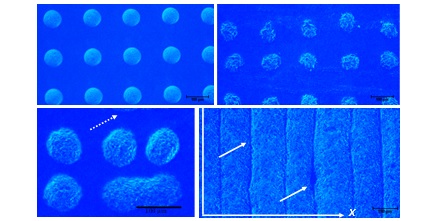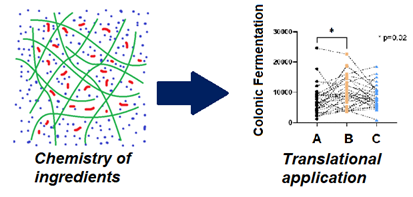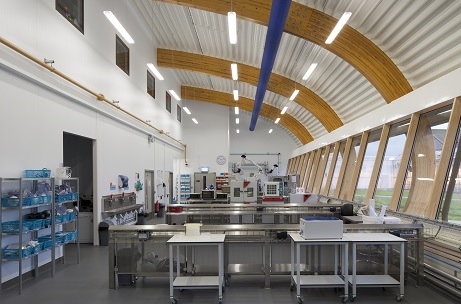Research themes
Natural multicomponent ingredients and nutrients: Professor David Gray's team research novel, bio-innovative approaches of incorporating lipid-rich organelles (oleosomes and chloroplasts) into the diet to improve health, and to reduce the impact on the environment. Read more about this work here.

Sustainable food processing: Dr Jo Gould and her team explore ways of incorporating sustainable sources of protein into food microstructures, by understanding the relationship between processing, functionality and safety of ingredients. Read more about this work here.

Microstructure design and engineering: Dr Vincenzo di Bari's research focuses on understanding the self- and engineered assembly of established, emerging and underutilised biomaterials to enable microstructure design and manufacture of ingredients and food products.

Functional Food Chemistry: Dr Joshua Reid’s research interests focus on the translation of the fundamental chemistry of food and beverage ingredients to their successful application across a range of challenges. Read more about this work here.

Research facilities and expertise
The Food Materials Research Group is leading innovation in:
- Food formulation and processing through increased understanding of the material properties of ingredients, their interplay, and the microstructure of foods
- Mechanisms underpinning oral processing and providing applied approaches for analysing the structure-oral processing-sensory perception links.
- Ingredient analysis, identification, structuring, and probing molecular and microstructural interactions.
- Instrumental characterisation techniques to enable multi-scale analysis of materials, including during dynamic processing.
Our extensive research facilities and material characterisation capabilities enable us to achieve detailed multi-scale analysis of foods and biomaterials, from molecules to the macro-scale, and to validate new manufacturing approaches in our pilot-plant facilities.

Contact Us
For more information and enquiries about research possibilities, please e-mail: helloFMRC@nottingham.ac.uk
 Linkedin UoN Food Materials Research Centre
Linkedin UoN Food Materials Research Centre
Research leaders
Our team encompasses 40 researchers working across four key themes, each led by an experienced academic:

Professor David Gray completed a PhD in plant lipid biochemistry at the University of Birmingham before joining Nottingham in 1993. He plays a key role in both teaching and research work at the University.
david.gray@nottingham.ac.uk
orcid.org/0000-0001-7621-3473

Dr Jo Gould completed her undergraduate and postgraduate studies at Nottingham, before becoming an Assistant Professor in the Food, Nutrition and Dietetics team in 2017.
joanne.gould@nottingham.ac.uk
orcid.org/0000-0002-7702-9771

Dr Vincenzo di Bari joined the University of Nottingham in 2014 after a PhD at the School of Chemical Engineering in Birmingham. He was appointed a Assistant Professor in Food Structure in 2021.
vincenzo.dibari@nottingham.ac.uk
orcid.org/0000-0001-9333-9764

Dr Joshua Reid completed his PhD in physical chemistry at the University of York, joining the University of Nottingham in 2020. He was appointed as Assistant Professor in Food Material Science in 2024.
joshua.reid@nottingham.ac.uk orcid.org/0000-0003-3187-2437
Recent Papers
Read about our latest research in these recent publications:
Rapeseed oleosomes facilitate intestinal lymphatic delivery and oral bioavailability of cannabidiol - 2024 - Ji, L et al, International Journal of Pharmaceutics
https://doi.org/10.1016/j.ijpharm.2024.124947
Emulsifiers and thickeners in our food - Do they alter gut permeability? - 2024 - Reid, J et al, Alimenary Pharmacology and Therapeutics https://doi.org/10.1111/apt.18222
Chloroplast/thylakoid-rich material: A possible alternative to the chemically synthesised flow enhancer polyglycerol polyricinoleate in oil-based systems - 2023 - Sutcharit. P et al, Food Research International
https://doi.org/10.1016/j.foodres.2023.112472
Thermally treated peanut oil bodies as a fat replacer for ice cream: Physicochemical and rheological properties - 2023 - Zaaboul, F et al, Food Chemistry
https://doi.org/10.1016/j.foodchem.2023.137630
Formulation engineering of water-in-oil-in-water emulsions for salt reduction with sucrose oleate as a PGPR-alternative lipophilic emulsifier - 2023 - Zhang, L et al, Food Structure
https://doi.org/10.1016/j.foostr.2023.100309
Non-starch polysaccharides in beer and brewing: A review of their occurrence and significance - 2022 - Reid, J. et al, Critical Reviews in Food Science and Nutrition
https://doi.org/10.1080/10408398.2022.2109585